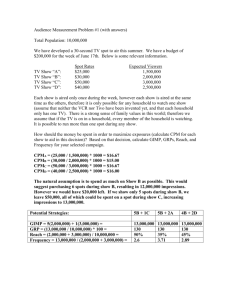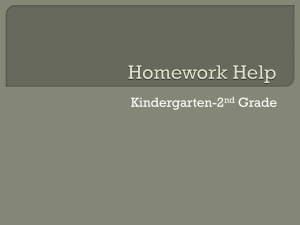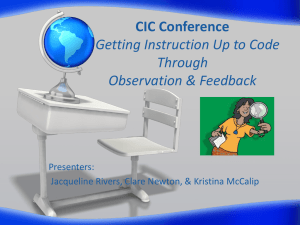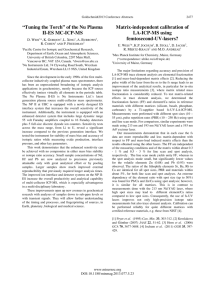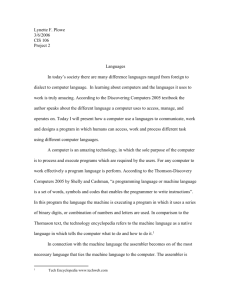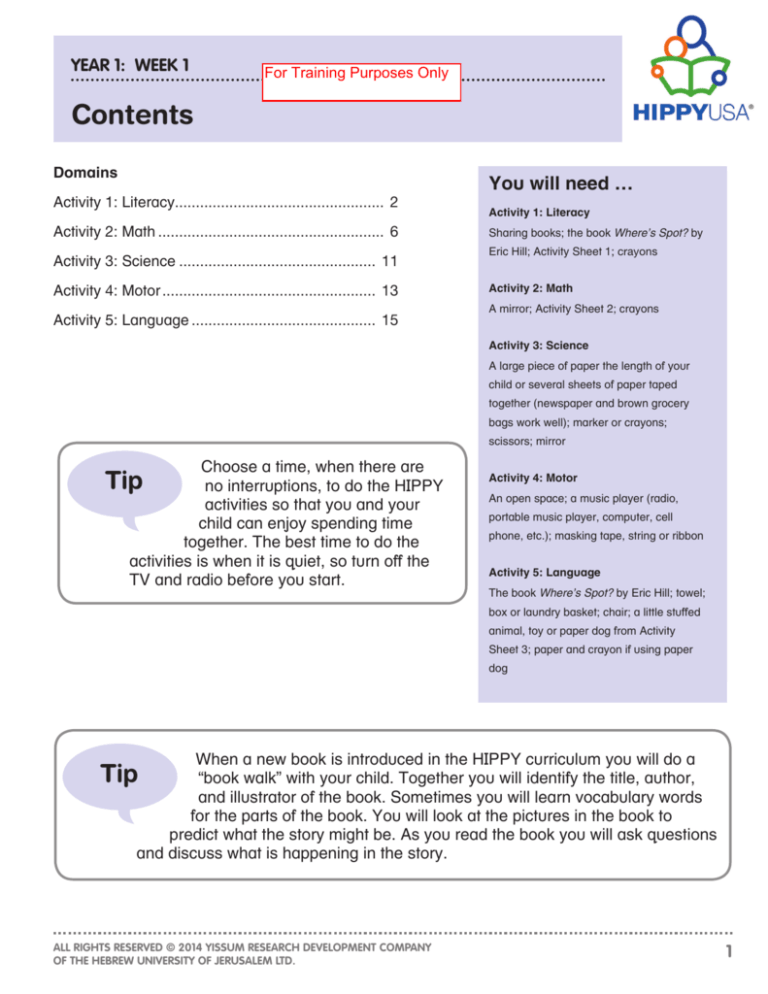
YEAR 1: WEEK 1
For Training Purposes Only
Contents
Domains
Activity 1: Literacy................................................... 2
Activity 2: Math....................................................... 6
Activity 3: Science................................................ 11
Activity 4: Motor.................................................... 13
Activity 5: Language............................................. 15
You will need …
Activity 1: Literacy
Sharing books; the book Where’s Spot? by
Eric Hill; Activity Sheet 1; crayons
Activity 2: Math
A mirror; Activity Sheet 2; crayons
Activity 3: Science
A large piece of paper the length of your
child or several sheets of paper taped
together (newspaper and brown grocery
bags work well); marker or crayons;
scissors; mirror
Choose a time, when there are
no interruptions, to do the HIPPY
activities so that you and your
child can enjoy spending time
together. The best time to do the
activities is when it is quiet, so turn off the
TV and radio before you start.
Tip
Activity 4: Motor
An open space; a music player (radio,
portable music player, computer, cell
phone, etc.); masking tape, string or ribbon
Activity 5: Language
The book Where’s Spot? by Eric Hill; towel;
box or laundry basket; chair; a little stuffed
animal, toy or paper dog from Activity
Sheet 3; paper and crayon if using paper
dog
When a new book is introduced in the HIPPY curriculum you will do a
“book walk” with your child. Together you will identify the title, author,
and illustrator of the book. Sometimes you will learn vocabulary words
for the parts of the book. You will look at the pictures in the book to
predict what the story might be. As you read the book you will ask questions
and discuss what is happening in the story.
Tip
All rights reserved © 2014 Yissum Research Development Company
of the Hebrew University of Jerusalem Ltd.
1
YEAR 1: WEEK 1
For Training Purposes Only
Activity 1: Literacy, Where’s Spot?
Literacy
What your child will learn from this activity
This is the first time you will share this book with your child. Children learn many things
when you read books to them.
• Your child will enjoy spending time with you.
• Your child will learn about what books are and how to use them.
• Your child will learn listening skills.
• Looking at pictures, listening to you read the book and talking about it will help your
child learn new words and ideas.
You will need
• The book Where’s Spot? by Eric Hill
• Activity Sheet 1
• Crayons
What to do
1. (Find a comfortable spot and choose a good time to share
the book.)
Look at the picture on the cover of this book. Can
you tell me what you think this book is about from the
picture?
(Accept your child’s answers.)
This book is about a dog named Spot. He is hiding.
(Point to the title.) The book is called, Where’s Spot?
(Point to the author’s name.) Eric Hill is the author. He wrote the story. He also drew
the pictures in the story.
2. (Open to page 1 and point to the dog and say:)
This is Sally. She is looking for Spot.
(Read and point to the names on the food bowls on page 1 out loud.)
Sally. Spot.
All rights reserved © 2014 Yissum Research Development Company
of the Hebrew University of Jerusalem Ltd.
2
1: WEEK 1
YEAR
For Training Purposes Only
Activity 1: Literacy, Where’s Spot?
Literacy
What do you think might happen in this story?
(Accept your child’s answer and write it on the line below.)
Let’s read the book and find out what happens.
3. (Read the book together. When finished reading the story,
talk about it using the following questions.)
Do you remember some of the places Sally looked for Spot?
–inside the clock, under the bed, etc.
(Turn through the pages to help your child remember. Confirm your child’s correct
responses.)
How do you think Sally felt when she couldn’t find Spot?
–scared, afraid
(Or help your child with some feeling words.)
4. (Turn to page 19 with the picture of Spot in the basket.)
Where did Sally find Spot?
–in the basket
Sally and Spot are now together. How do you think they feel?
–happy, glad
5. (Look at the last page)
Let’s look at the last page. What does Spot do at the end of the story?
– eats his food, lunch or dinner
All rights reserved © 2014 Yissum Research Development Company
of the Hebrew University of Jerusalem Ltd.
3
1: WEEK 1
YEAR
For Training Purposes Only
Activity 1: Literacy, Where’s Spot?
Literacy
What was your favorite part of the story?
Where could Spot hide in our home?
(Point to a picture of Spot in the book and show his spots.)
Spot was named Spot because he had spots on him.
(Place Activity Sheet 1 on the table in front of your child. Point to the picture of the dog.)
Here is a picture of a dog. Let’s give it some spots. You can color and draw in the
picture however you want.
6. (Turn the page to the blank side.)
Draw anything you want on this side of the page.
(Encourage your child’s creativity and let them draw anything they like.)
Tell me about this picture. What did you draw? What should we call it? I’m going to
write your name and the title of your picture.
(Write your child’s name and a title on the picture.)
We had fun reading and making a picture today. Let’s find a place to hang up
your work.
Things to
think about
and do
• Talk with your child about taking care of books and a safe place
to keep their new book.
• You may need to help your child hold the crayon. This type of
grasp can be challenging for young children.
• Continue to re–read the book many times over the week and
talk about it. Children enjoy hearing stories over and over again.
All rights reserved © 2014 Yissum Research Development Company
of the Hebrew University of Jerusalem Ltd.
4
1: WEEK 1
YEAR
For Training Purposes Only
Activity Sheet 1: Literacy, Where’s Spot?
Literacy
Name:
All rights reserved © 2014 Yissum Research Development Company
of the Hebrew University of Jerusalem Ltd.
5
YEAR 1: Week 1
For Training Purposes Only
Activity 2: Math, Numbers and Counting
Math
What your child will learn from this activity
In this activity your child uses the math concept: counting. Children learn through
repetition. They need many opportunities to learn to count. In this lesson, your child will
count body parts and name how many parts there are.
You will need
• Mirror
• Activity Sheet 2
• Crayons
What to do
1. (Hold a hand mirror or have your child stand in front
of a mirror.)
Today we will play a counting game.
Put your hands on your head.
How many heads do you have? –1
Point to your mouth.
How many mouths do you have? –1
Point to your nose.
How many noses do you have? –1
Point to your eyes.
How many eyes do you have?
Count them. –1, 2
Point to your ears.
How many ears do you have?
Count them. –1, 2
All rights reserved © 2014 Yissum Research Development Company
of the Hebrew University of Jerusalem Ltd.
6
1: WEEK 1
YEAR
For Training Purposes Only
Activity 2: Math, Numbers and Counting
Math
Hold out your hands. How many hands do you have?
Count your hands. –1, 2
2. (Move to a table and put one hand on the table.)
Look at my hand.
Let’s count my fingers .
(Count with your child.) –1, 2, 3, 4, 5
Five fingers!
Show me your hand.
Let’s count the fingers on one of your hands.
(Count with your child.) –1, 2, 3, 4, 5
Five fingers!
3. We are going to play a finger hiding game.
I will go first.
(Put your hand behind your back and fold down
your thumb. Bring your hand out and hold it up
with four fingers up.)
How many fingers do I have up?
Count them.
(Count with your child.) –1, 2, 3, 4
Again, I’ll hide some fingers.
(Put your hand behind your back and fold down your thumb and pinky. Bring your hand out
and hold it up with three fingers up.)
How many fingers do you see?
All rights reserved © 2014 Yissum Research Development Company
of the Hebrew University of Jerusalem Ltd.
7
1: WEEK 1
YEAR
For Training Purposes Only
Activity 2: Math, Numbers and Counting
Math
Count them.
(Count with your child.) –1, 2, 3
One more time.
(Put your hand behind your back and fold down
your thumb and last two fingers. Bring your hand
out and hold it up with two fingers up.)
How many fingers can you see now?
Count them. –1, 2
4. Your turn! Now you hide as many fingers as you want.
(Count out loud.)
I see ____finger(s).
You hide some fingers again.
(Count out loud.)
I see ____finger(s).
One more time.
(Count out loud.)
I see ____finger(s).
(Follow your child’s lead if they want to continue the game.)
5. (Place Activity Sheet 2 and a pencil on the table in front of your child.)
Let’s trace your hands! Place one hand on this paper.
(Trace around your child’s hand. If your child wants to try tracing let them do it.)
All rights reserved © 2014 Yissum Research Development Company
of the Hebrew University of Jerusalem Ltd.
8
1: WEEK 1
YEAR
For Training Purposes Only
Activity 2: Math, Numbers and Counting
Math
Let’s count the fingers on this hand.
(Count them together.)
You have five fingers!
Place your other hand next to this hand. (Point to hand.)
(Trace that hand on Activity Sheet 2. Allow your child to do the tracing if they would like.)
How many fingers do you have on this hand? –5
You have five fingers on this hand too! I will write your name at the top of your
page. (Say each letter as you print the letters on the page.)
You may decorate your hands if you would like.
Things to
think about
and do
• Make a dog face out of cardboard or paper, creating a big hole
for the mouth. Cut 5 bones out of cardboard to feed the dog. Either
you or your child can pretend to be the “talking dog” and ask for
a specific number of bones you want. You both can count as the
bones are being fed. Add more bones as your child learns to count
to higher numbers.
• Blow bubbles; have your child count the bubbles they blow or
the bubbles they pop.
• Place 5 small objects all of the same kind (such as buttons,
caps, paper clips, marbles, cotton balls) in a clear plastic bag. Ask
your child to guess how many objects are inside the bag. Then
count the objects together.
All rights reserved © 2014 Yissum Research Development Company
of the Hebrew University of Jerusalem Ltd.
9
1: WEEK 1
YEAR
For Training Purposes Only
Activity Sheet 2: Math, Numbers and Counting
Math
Name: _________________________________________________________
All rights reserved © 2014 Yissum Research Development Company
of the Hebrew University of Jerusalem Ltd.
10
YEAR 1: WEEK: 1
For Training Purposes Only
Activity 3: Science, My Body
Science
What your child will learn from this activity
When children learn about their bodies they develop self-awareness. The My Body series
begins with the whole body and will build upon each activity. Your child will discover more
about the parts of the body during the next few weeks.
You will need
• Large piece of paper the length of your child
or several sheets taped together (newspaper
and brown grocery bags work well)
• Markers or crayons
• Scissors
• Mirror (full length, large enough for child to
stand and see their body)
What to do
1. Today, let’s talk about our bodies.
First, let’s go look in the mirror.
Tell me what you see.
– my body, me, etc.
I see you in the mirror!
I see your head (touch your child’s head).
I see your arms (touch your child’s arms).
I see your hands (touch your child’s hands).
I see your tummy (touch your child’s tummy/stomach).
I see your legs (touch your child’s legs).
I see your feet (touch your child’s feet).
All rights reserved © 2014 Yissum Research Development Company
of the Hebrew University of Jerusalem Ltd.
11
1: WEEK 1
year
For Training Purposes Only
Activity 3: Science, My Body
Science
2. Listen. I will ask you to point to different parts of your body.
Show me your head. (Your child may need assistance pointing to or touching their
head.)
Show me your arms.
Show me your hands.
Show me your tummy.
Show me your legs.
Show me your feet.
3. (Take out the large paper, crayons or markers, and scissors.)
Ok, now let’s draw a body like yours. First, you will need to lie down on this paper. I
will draw all around your body.
4. You can get up and look at what I drew.
Look, I traced the shape of your body. I’m going to cut it out now.
(Cut out the body outline.)
5. Let’s look for a place to hang up your body. We need to save it so that we can
work on it another day. Where would be a safe place to hang up our work?
Note: If you do not have a place to hang up your child’s outline, fold it gently and store it
somewhere safe. It will be used for other lessons in the coming weeks.
Things to
think about
and do
•
Name body parts when you are getting dressed, walking to the
park, or reading a book this week. You can always use your child’s
body outline to talk about body parts as well.
•
When you see animals in books, pictures, magazines or in the
real world, talk with your child about the animals’ bodies.
All rights reserved © 2014 Yissum Research Development Company
of the Hebrew University of Jerusalem Ltd.
12
YEAR 1: WEEK 1
For Training Purposes Only
Activity 4: Motor, Moving My Body
Motor
What your child will learn from this activity
The Moving My Body series focuses on developing your child’s gross motor control and
spatial perception. Spatial perception is what helps your child learn how to move about
in different surroundings without bumping into things, or knowing where to place letters
on paper when writing. The activities are meant to be fun and invite your child to move in
different ways. In this first activity your child will develop gross motor control by walking
slow and fast and by marching. Your child’s vocabulary expands through listening and
following directions..
You will need
• An open space
• A music player (radio, portable music player, cell phone, etc.)
• Masking tape or string/ribbon
What to do
1. (Create a large circle on the floor with
masking tape or string. Stand with your
child on the outside of the circle.)
There are different ways to move
around the circle.
I will walk around the circle. Watch me.
Now you try walking around the circle.
(Allow your child to walk around the circle.)
I will walk slowly around the circle.
Watch me. Now you try walking slowly
around the circle. (Allow your child to
walk slowly around the circle.)
I will walk fast around the circle. Watch
me. Now you try walking fast around
the circle. (Allow your child to walk fast
around the circle.)
All rights reserved © 2014 Yissum Research Development Company
of the Hebrew University of Jerusalem Ltd.
13
1: WEEK 1
YEAR
For Training Purposes Only
Activity 4: Motor, Moving My Body
Motor
I will march around the circle. Watch
me. Now you try marching around the
circle. (Allow your child to march around
the circle.)
2. (Play some slow music.)
Let’s walk slowly around the circle to
the music. (Walk slowly around the circle.)
(Play some faster music.)
Now let’s walk fast around the circle to
the music. (Walk fast around the circle.)
(Play some music with a marching beat.)
Let’s march around the circle to the
music. (March around the circle to the
music.)
Things to
think about
and do
• You are exposing your child to shapes when you are talking
about a circle and walking in a circle. Continue to describe
shapes, colors and other things this week.
• Play walking games when you are out and about this week. It
can be fun to walk slow, fast or march to the mailbox or on the
sidewalk.
All rights reserved © 2014 Yissum Research Development Company
of the Hebrew University of Jerusalem Ltd.
14
YEAR 1: Week 1
Hello
For Training Purposes Only
Activity 5: Language, Where’s Spot?
Language
What your child will learn from this activity
In this activity your child will develop literacy skills as you read the story again. Playing
games allows your child to learn while having fun. When your child hides, or hides a toy,
they learn about spatial perception and the concept of under.
You will need
• Where’s Spot? by Eric Hill
• Towel
• Box or laundry basket
• Little stuffed animal or toy (optional paper dog
from Activity Sheet 3 if you don’t have a small toy)
• crayon and scissors if using paper dog
• Chair
What to do
1. (Sit down in a comfortable place with your child. Look at the cover of the book, Where’s
Spot?)
Let’s read this book about Spot again.
2. (Read the book.)
Sally looked for Spot in a lot of places. She looked under the stairs, under the bed,
under the rug.
(Give your child the toy. If you are using the paper dog, ask your child if they’d like to color
it before you cut it out.)
Here is another dog named Spot! You close your eyes and Spot will hide under
something and you can find him.
(When your child closes her eyes, put Spot under the towel.)
3. Open your eyes, where’s Spot? Is he under the chair? –no
Is he under the box (or laundry basket)? –no
Is he under the towel? –yes!
All rights reserved © 2014 Yissum Research Development Company
of the Hebrew University of Jerusalem Ltd.
15
1: Week 1
YEAR
For Training Purposes Only
Activity 5: Language, Where’s Spot?
Hello
Language
Close your eyes again and Spot will hide again.
(Hide Spot under the box or laundry basket.)
Ok, open your eyes! Where’s Spot?
Is he under the chair? –no
Is he under the towel? –no
Is he under the box (or laundry basket)? –yes!
4. (Play the game again, this time hide Spot under the chair. If your child likes the game, you
can hide Spot under other things. You can also let your child be the leader and hide Spot,
so that you can find him.)
5. Now you hide. Listen and I’ll tell you where to hide.
Hide under the towel.
Hide under the chair.
Hide under the laundry basket (or box).
Was it easy to hide under all of those things?
Why? (Accept any reasonable answers.)
Things to
think about
and do
• Continue playing and change the game to a guessing game.
Ask you child to close his or her eyes while you hide the toy. Then
ask your child to guess where you hid it.
ä
I put Spot under the place where you sleep. Where do you think Spot is? –under my bed, pillow
ä I put Spot under something you sit on. Where do you think Spot is? –under the chair
ä I put Spot in the place where you keep your clothes.
Where do you think Spot is?– in the closet, in my dresser
All rights reserved © 2014 Yissum Research Development Company
of the Hebrew University of Jerusalem Ltd.
16
1: Week 1
YEAR
For Training Purposes Only
Activity Sheet 3: Language, Where’s Spot?
Hello
Language
(Let your child color the dog however she likes. Cut out along the dotted lines and fold to
use with the activity.)
Cut Along Dotted Lines
Fold
All rights reserved © 2014 Yissum Research Development Company
of the Hebrew University of Jerusalem Ltd.
17



